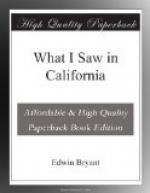There are no reliable statistics in California. The traveller is obliged to form his estimate of matters and things chiefly from his own observation. You can place but little reliance upon information derived from the population, even when they choose to answer your questions; and most generally the response to your inquiries is—“Quien sabe?” (who knows?) No Californian troubles his brains about these matters. The quantity of wines and aguardiente produced by the vineyards and distilleries, at and near Los Angeles, must be considerable—basing my estimate upon the statement of Mr. Wolfskill, an American gentleman residing here, and whose house and vineyard I visited. Mr. W.’s vineyard is young, and covers about forty acres of ground, the number of vines being 4,000 or 5,000. From the produce of these, he told me, that last year he made 180 casks of wine, and the same quantity of aguardiente. A cask here is sixteen gallons. When the vines mature, their produce will be greatly increased. Mr. W.’s vineyard is doubtless a model of its kind. It was a delightful recreation to stroll through it, and among the tropical fruit-trees bordering its walks. His house, too, exhibited an air of cleanliness and comfort, and a convenience of arrangement not often met with in this country. He set out for our refreshment three or four specimens of his wines, some of which would compare favourably with the best French and Madeira wines. The aguardiente and peach-brandy, which I tasted, of his manufacture, being mellowed by age, were of an excellent flavour. The quantity of wine and aguardiente produced in California, I would suppose, amounted to 100,000 casks of sixteen gallons, or 1,600,000 gallons. This quantity by culture can be increased indefinitely.
It was not possible to obtain at Los Angeles a piece of woollen cloth sufficiently large for a pair of pantaloons, or a pair of shoes, which would last a week. I succeeded, after searching through all the shops of the town, in procuring some black cotton velvet, for four yards of which I paid the sum of 12 dollars. In the United States the same article would probably have cost 1.50 dollar. For four dollars more I succeeded in getting the pantaloons made up by an American tailor, who came into the country with General Kearny’s forces. A Rocky Mountain trapper and trader (Mr. Goodyear), who has established himself near the Salt Lake since I passed there last year, fortunately arrived at Los Angeles, bringing with him a quantity of dressed deer and elk skins, which were purchased for clothing for the nearly naked soldiers.
Among the houses I visited while here, was that of Mr. Pryor, an American, and a native of Louisville, Ky. He has been a resident of the country between twenty and thirty years, but his Kentucky manners, frankness, and hospitality still adhere to him.
I remained at Los Angeles from the 14th to the 29th of January. During this time, with the exception of three days, the weather and temperature were pleasant. It rained one day, and during two days the winds blew strong and cold from the north-west. The nights are cool, but fires are not requisite to comfort. The snow-clad mountains, about twenty-five or thirty miles to the east of us, contrast singularly with the brilliant fresh verdure of the plain.




